MNTL Day Exposes UHS Students to Nanotechnology Research During I-STEM’s Summer Multidisciplinary Camp
September 29, 2017
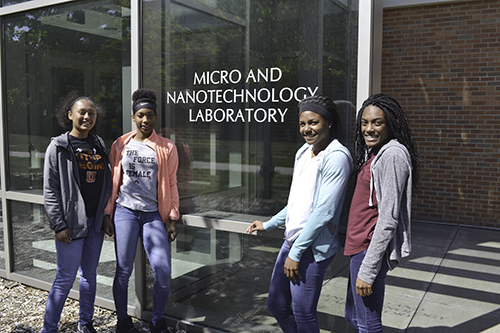
Four UHS athletes outside of the MNTL
On Tuesday, August 8, MNTL Day, the 27 Urbana High School (UHS) student athletes who participated in I-STEM’s pilot summer camp, a multi-disciplinary STEM program, visited MNTL (the Micro and Nanotechnology Lab) for “A Primer on Semiconductors.” Students had the opportunity to hear from each of the eleven P–20 STEM teachers who participated in the nano@illinois Research Experience for Teachers (RET), funded by the National Science Foundation where they did cutting-edge research in nanotechnology under some of Illinois’ premier researchers in the field. In the afternoon, Dr. Mark McCollum led students on a tour of MNTL’s cleanroom laboratory.
In addition to hearing about the research done by the eleven nano@illinois RET teachers, the goal was for them to closely evaluate the poster presentations teachers did about their research this past summer, in preparation for creating their own poster about their I-STEM camp experience. Students used a rubric to evaluate each teacher’s presentation according to the following four criteria: organization, use of graphics, effectiveness, and responsiveness, giving each a grade from 1 to 3.
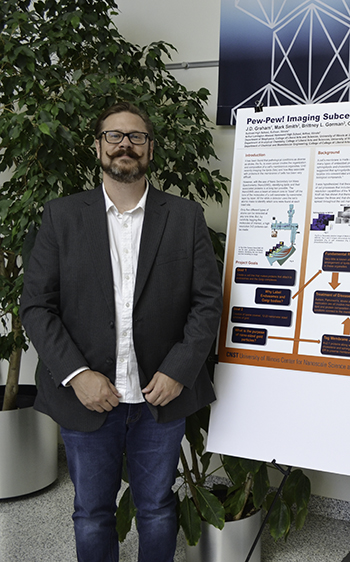
nano@illinois teacher, J. D. Graham, and his poster
For instance, one Nano@Illinois RET participant, J. D. Graham, who teaches biological sciences to grades 9-12 at Sullivan High School in Sullivan, Illinois, shared a poster about his research, which involved using a nanoSIMS machine to separate out atoms or ions according to their mass by sputtering (hitting a cell and exploding an area over and over), thus removing layer by layer, nano-meter by nano-meter, to create a 3D model of where all of those atoms were, then label them and associate them with certain organelles, enabling researchers to learn their composition and their position, which has never been done before at this resolution.
Graham shares why the I-STEM camp was a good experience for the UHS students.
"It's just exposure," he acknowledges. "It's like learning another language; it's like going to another country. You can hear that those things exist, but to actually see somebody speak a language, it takes the mystery away that it's not something somebody else does, it's something you can do."
Another teacher who shared his poster with the high-schoolers was Antonio Gamboa, who teaches Chemistry, Biology, and AP classes in Pomona, CA. While he also worked with cells and neurons during his research this summer, one significant accomplishment that relates to his high school students was the creation of a solar panel. “So the students will be able to create a solar panel in the classroom,” he says, “and it’s really fast, easy, inexpensive; the lesson is all written and available for teachers; so it's really exciting.”
Regarding why the high school students should be exposed to research, Gamboa says, “It's essential. I mean high school students—anybody should participate. I think they should be exposed to the fact of being able to try to find out something new. Just to learn something you didn't know and to question, I think is fantastic. That's a great opportunity.”
Regarding the positive impact participating in the I-STEM camp and attending their poster presentation had on the local high schoolers, Gamboa shares why it was good for the students to come to something like this:
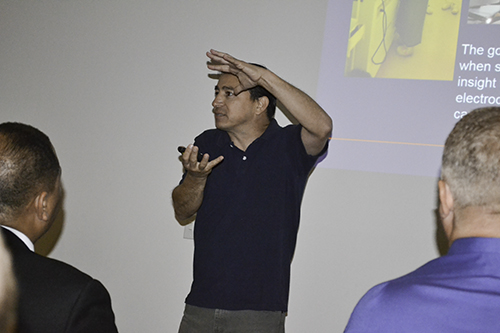
nano@illinois teacher, Antonio Gamboa, presents his research
“It opens up their eyes,” he says. “It's very difficult in high school to be able to see the opportunities. You can tell them, talk to them, show them, but there's nothing like walking on a campus, seeing the buildings, talking to people, seeing the posters, seeing everything. It all becomes real."
And according to Gamboa, after students participate in programs like this, there's a noticeable change. "You notice it when they come back, they are different. What I notice is that they come back and they're ready to go to college. They're excited, motivated, and now they see that it's real. So many of the communities don't have this exposure. They don't have doctors or lawyers; they don't have anybody. You tell them and it seems to be open in the air, like maybe it's for someone else. But once they come, they realize that, ‘Maybe, this is something for me!’ And that is life changing.”
In addition to listening to a evaluating the presentations, the students also spent time with Dr. Mark McCollum a principal research engineer at MNTL, who explained how semiconductors work and why cleanrooms are important to research going on at MNTL. He also discussed a number of instruments that MNTL researchers use. To cap off the day, the students then suited up for a tour of the cleanrooms.
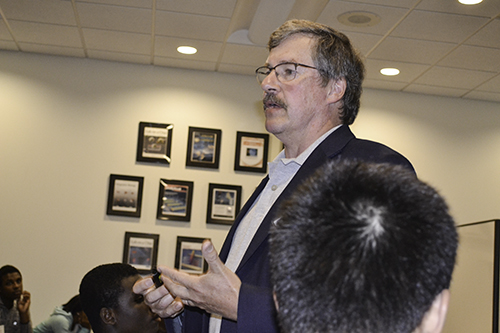
Dr. Mark McCollum, principal research engineer at MNTL, speaks to the campers
Regarding why it was important to bring high school kids on campus in an event like I-STEM camp, Shawn Hampton, UHS Academic Coach explains, “I feel it's important because inspiration. I feel children need to be inspired and they also need to be exposed. I feel a lot of the things I do now are the things I did in high school or grade school. And so it's important for them to be exposed at a young of age as possible to possibly find something that they love.”
In his role as academic Coach, he says one important aspect of the program is exposure, which is why the I-STEM camp was important. In fact, Hampton expects that in the future, they’ll see results. He shares an anecdote:
“So one of the philosophies that we uphold is the principle of the bamboo seed. When you plant a bamboo seed, it takes 5 years before growth. You have to nurture it, you have to feed it, you have to water it. After year one you get nothing. After year 2 you get nothing. After year 3 you're still looking at a piece of ground that has no growth. Year 4, and in year 5 that bamboo seedling actually grows 90 feet.”
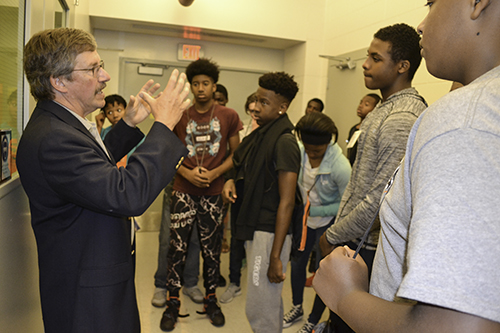
Dr. Mark McCollum explains why cleanrooms are important to research going on at MNTL
Regarding the impact of events like the I-STEM camp, he says it may take a while. And the way we look at our children is that they're all bamboo seedlings,” he continues. “Even though we’re pouring into them, were exposing them, we're giving them different opportunities, we're not seeing the result like we expect to see the result. But what I want to let people know, is that it's happening. And it's going to come out, and it's going to come out really fast, but it's going to come out much later. And so, I may not see how I've impacted these kids this year, or even next year. But what I know is that in 10 years, there's going to be something that they really grab hold of. And that's really what it's about.”
Does he expect to get a call in, say, 10 years saying “Hey coach, that was so important!”?
Yep, and then he says he expects to hear something like, “’I just built this missile,’ or “I just made this code!’”
Author/Photographer: Elizabeth Innes, Communications Specialist, I-STEM Education Initiative
More: 8-12 Outreach, I-STEM Initiatives, MNTL, nano@illinois, RET, STEM Pipeline, Summer Camp, Underserved Students/Minorities in STEM, Urbana High School, 2017
For additional articles about I-STEM's 2017 Summer Camp, see:
- I-STEM Multidisciplinary Summer Program Exposes UHS Athletes to Different STEM Departments/Units
- MCBees Use “Whodunit?” to Pique UHS Students’ Interest in Science During I-STEM Summer Camp
- Akono and Company Teach UHS Students About Civil Engineering and Strength of Materials During I-STEM’s Multidisciplinary Summer Camp
- ECE Day at I-STEM’s Multidisciplinary Summer Camp: Soldering, Circuits, and Software
- Math Day at I-STEM’s Multidisciplinary Summer Camp Adds Up to Fun
- During I-STEM Summer Camp, Urbana High School Students’ Understanding of Aerospace Engineering Soars
- UHS Students Explore Computer Science, Coding, During I-STEM Camp’s CS Day
- At I-STEM's Multidisciplinary Summer Camp, UHS Students Have Fun with Chemistry—Everything From Soap Making To Glow Sticks to Ice Cream
- UHS Students Gear Up for Mechanical Science and Engineering During I-STEM Summer Camp
- During I-STEM Camp’s NCSA Day, UHS Students Experience Data Visualization, Super Computers, and NCSA’s Research
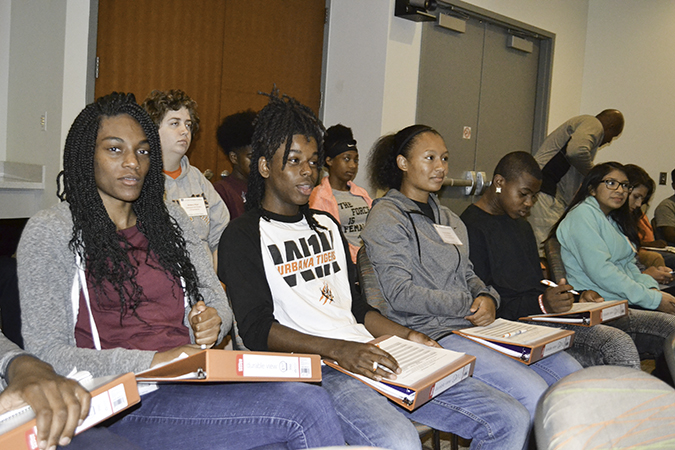
UHS students during a tour of the MNTL













.jpg)
















